#ancient greek calendars
Text
Calendar manipulation in Ancient Greece
This really isn’t a topic I’m thrilled to tackle, but since the Theogamia there has been so much talk about calendar discrepancies that it looks like the right time to bring this up. Don’t expect this to be eloquent, I’m writing this while absolutely knackered.
I’m not going to focus too much on the problem of modern calendar reconstructions, what I’ll be going into here is the historical evidence we have about how awfully inconsistent the ancient Athenian calendar could be, either by nature or by human intervention over time.
The problem of the new moon
In theory, the Athenian calendar and other Greek calendars are lunar and each month begins on the new moon. Sacha Stern, in Calendars in Antiquity, tells us that the writer Geminus (1st c. BCE), states that the Greek month began when the new moon crescent was first sighted but Geminus also states that the new moon can sometimes be sighted on the 1st of the month, but sometimes not until the 3rd. This statement is interesting, because it implies that, should the moon not be visible (clouds), there was a mathematical basis to the calculation of the months that still made the month begin regardless of what the sky looked like.
There comes also the problem of conjunction (aka when the moon in orbit passes between the sun and the earth, making the moon invisible). The traditional ancient assumption is that the day of conjunction is the last day of the month. However, the interval between the day of conjunction and of the new moon is usually around two days; so if the month began when the new moon was first sighted, conjunction should have been typically on the penultimate day of the previous month.
Those difficulties, along the fact that other authors, such as Aratus give conflicting information leads Stern to say this:
Modern scholars have generally accepted Geminus’ statements that the Greek month began at first visibility of the new moon. However, it is clear on Geminus’ own evidence, as well as on the evidence of the other passages just mentioned, that this rule was not strictly followed, and indeed, quite possibly, that it did not constitute a rule. Moreover, we do not know of any procedure that may have been used, and indeed that would have been necessary, for such a rule to be enforced. There is no evidence, for example, in the whole of Graeco-Roman literature of anyone sighting the new moon.
And this leads us to the rather uncomfortable idea that, in practice, a lot of the calendars simply might not have been as well aligned with astronomical moon phases in the way we conceptualize it today.
Francis M. Dunn, in an article titled Tampering with the Calendar, lists passages from ancient Greek sources that seem to corroborate this idea:
Thucydides 2.28 in a passing mention of a solar eclipse […] distinguishes the astronomical "new moon" or conjunction, at which eclipses must occur, from the conventional "new moon" or noumenia, which followed the first visible crescent. The historian, in other words, is aware that there is an astronomical "new moon" or conjunction which is different from the first day of the civic month.
Man-made adjustments
Because calendars impacted the religious, civic and political lives of each city-states, it wasn’t uncommon for city-states to make adjustments to them.
The type of modification we’re most used to is the addition of intercalary days or month that aim to realign the calendar with astronomical reality. But we have evidence that this isn’t the only motivation.
For example:
In the 430's (SEG XXXVI 12), 420's (SEG XL 12) or 410's (SEG XLII 17), in connection with offerings at Eleusis, the demos instructed the archon to add a second Hekatombaion.
In 228/7 a second Hekatombaion was added to the civic calendar.
Between 294 and 288, in connection with a tour by artists of Dionysus during Lenaion, four cities in Euboea made provision for the archons to add months as necessary.
At the end of the fourth century, probably in 307/6, two days were apparently added near the end of Gamelion.
In 271/0 four days were added in the first decade of Elaphebolion.
As we can see, additions and subtractions of one or several days, if not sometimes months, could happen. They were often added either at the beginning of a month or at the end of a month, which makes it easier to imagine that it could be done to readjust the calendar to the moon, but in the cases where it was linked to a festival, it was clearly done to schedule said festival:
”Of the three cases of intercalary months, two are explicitly related to religious festivals (the dedication of first fruits at Eleusis, IG I3 78; and dramatic festivals in Euboea, IG xii.9 207”
“The evidence therefore supports an assumption that most adjustments were part of the normal operation of the civic calendar - ensuring that the calendar was roughly in phase with sun and moon, and ensuring that festivals would take place at a necessary or convenient time.”
An insoluble debate
The problem of ancient Greek calendars as a whole has been a point of contention among scholars for so long, for the simple reason that it makes dating anything difficult. The most notable example is the one around the differences between the Athenian calendar and the Spartan one when it comes to dating something like the battle of Marathon. Plutarch tells us it was on the 6th of Boedromion, but Herodotus tells us it was during the full moon (and therefore later, if the calendars matched the lunar cycle). This is where the issue of inter-city calendar alignment emerges, since each city-state functioned in their own independent ways, they could resort to calendar adjustments at any time they wanted and further misaligning themselves with one another.
But scholars don’t necessarily agree! Some, like Pritchett believed that the calendars were irregular no matter what, while others like Meritt believed they were regular, and that the evidence of irregularity was due to exceptional circumstances. The problem at this point is that it is much harder to prove regularity than the opposite.
So where does it leave us?
The reconstructed calendars we use today as modern worshippers are all based on some form of regularity, but we need to remember that none of them are a direct continuation of the ancient calendars. For the most part, they are based on the metonic cycle and on the other luni-solar calendars in use today by various faiths and cultures around the world. In fact, a lot of the reconstructions of Athenian calendars are using the same mathematical model as the Hebrew calendar. And that, in a nutshell, explains why different reconstruction have different results when it comes to placing specific days and festivals. So it really comes down to personal choice. Choosing a calendar that is more “popular” might be more appealing to you for particular reasons, while others might choose their calendar based on entirely different criteria. I guess the point I’m trying to get to is that, there won’t be a “standard” calendar without some kind of wide decision to stick to a precise model, and as long as there is no religious authority, the calendars will remain ever so slightly different, because they never really were regular in the way that we understand our solar Gregorian calendar to be.
90 notes
·
View notes
Text
valgrace bday week

#who dosent have fictional ppls bdays in their calendars anyway!!#julys first week starts with jasons birthday and ends with leos#and the following friday is annabeth’s birthday!!!#honestly i love valgrace so much platonically#ᝰ fay [ft. voices in head] .ᐟ#pjo#pjo hoo toa#hoo#heroes of olympus#leo valdez#jason grace#annabeth chase#percy jackson#perseus jackson#rick riordan#percy jackson and the olympians#ancient greek mythology#the heroes of olympus#trials of apollo#the trials of apollo#rrverse#riordanverse#rick riordan universe#chb#cj#camp half blood#camp half-blood#camp jupiter#july#calendar
68 notes
·
View notes
Text
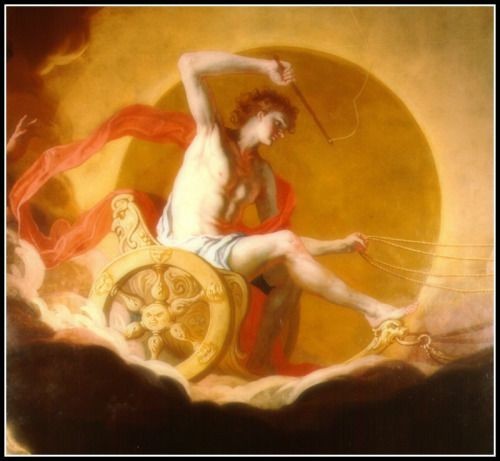
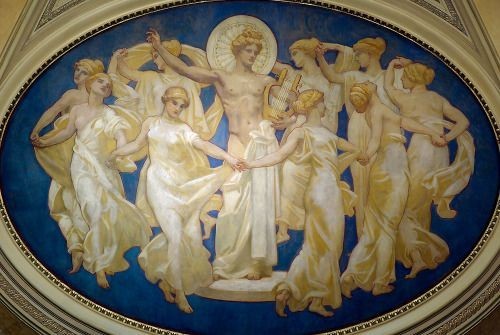
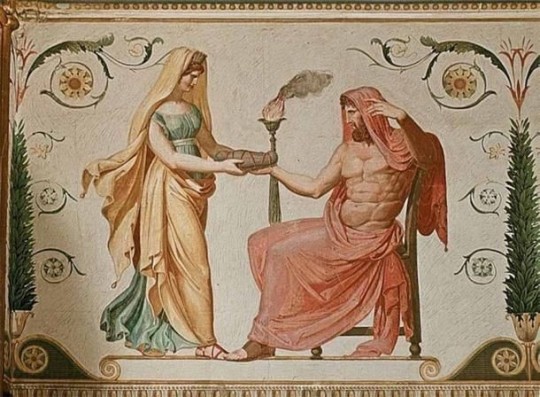
9 Metageitniōn| Μεταγειτνιών (Attic Calendar) - 14th of August/ 20th-24th of August
Helios (Ἡλιος), The Muses (Μουσαι) and Rhea (Ρεια, Μητηρ Θεων)
The Muses are: Melpomene the Muse of tragedy held a tragic mask, Thaleia Muse of comedy a comedy mask, Terpiskhore Muse of dance a lyre, Kalliope the Muse of epic poetry a lyre, Kleio the Muse of history a stylus and scroll, Polymnia the Muse of hymns a veil and pensive pose, Ourania the Muse of astronomy a globe, Erato the Muse of erotic poetry a lyre, and Euterpe the Muse of lyric poetry a flute.
Hesiod, Theogony 1 ff (trans. Evelyn-White) (Greek epic C8th or 7th B.C.) :
"Of the Mousai Helikoniades (of Helikon) let us begin to sing, who hold the great and holy mount of Helikon, and dance on soft feet about the deep-blue spring and the altar of the almighty Kronion [Zeus], and, when they have washed their tender bodies in Permessos [stream of Helikon] or in the Hippokrene (Horse's Spring) or Olmeios [stream of Helikon], make their fair, lovely dances upon highest Helikon and move with vigorous feet"

Rhea, Mater Megala
Antoninus Liberalis, Metamorphoses 19 (trans. Celoria) (Greek mythographer C2nd A.D.) :
"In Krete there is said to be a sacred cave full of bees. In it, as storytellers say, Rhea gave birth to Zeus; it is a sacred place an no one is to go near it, whether god or mortal. At the appointed time each year a great blaze is seen to come out of the cave. Their story goes on to say that this happens whenever the blood from the birth of Zeus begins to boil up. The sacred bees that were the nurses of Zeus occupy this cave."

Ἡλιος
HELIOS (Helius) was the Titan god of the sun, a guardian of oaths, and the god of sight. He dwelt in a golden palace in the River Okeanos (Oceanus) at the far ends of the earth from which he emerged each dawn, crowned with the aureole of the sun, driving a chariot drawn by four winged steeds. When he reached the the land of the Hesperides in the far West he descended into a golden cup which bore him through the northern streams of Okeanos back to his rising place in the East.
Homeric Hymn 31 to Helius (trans. Evelyn-White) (Greek epic C7th - 4th B.C.) :
"Glowing Helios (Sun) whom mild-eyed Euryphaessa (Wide Shining), the far-shining one, bare to [Hyperion] the son of Gaia (Gaea, Earth) and starry Ouranos (Uranus, Heaven). For Hyperion wedded glorious Euryphaessa, his own sister, who bare him lovely children, rosy-armed Eos (the Dawn) and rich-tressed Selene (the Moon) and tireless Helios (Helius, the Sun) who is like the deathless gods."
#hellenistic#hellenic deities#hellenic pagan#hellenism#hellenic polytheism#hellenic worship#hellenic calendar#festivals#rhea#helios#the muses#deity#deity work#deity worship#pagan#paganism#paganblr#sources#greek#greek literature#greek deities#greek tumblr#greek mythology#greek gods#greek myth#greek myth art#greek posts#ancient greece#pagan witch#apollo
27 notes
·
View notes
Text

Hey so I made an Alternative Advent Calendar in 2021 with Ancient Greek Mythical Creatures in it. I made some physical copies and then a PDF to download-and-print at home because postage/time.

She got one 😁

I’m making another one this year with Ancient Greek Mythical Women, so I’ve made a fantasy temple version based on the Tholos of Athene outside Delphi and the Tholos temple of Vesta in the House of the Vestals, Rome. I’ve literally be thinking about it for an entire year 😂

Here’s a sly peek at it (uncut).
Is it pretty? I really want it to be pretty.
The old one download-and-print: https://greekmythcomixshop.wordpress.com/2021/11/06/new-ancient-greek-mythological-creatures-advent-calendar/
Also one that you can print blank for classes to colour in: https://greekmythcomixshop.wordpress.com/2021/11/10/new-ancient-greek-colour-in-draw-your-own-mythological-creatures-advent-calendar-teachers-edition/
#alternative advent calendar#ancient Greek advent calendar#greek mythology#tagamemnon#greek myth#illustration#greek myth comix#comix#Ancient Greek mythical women#ancient greek mythology#advent calendar#download and print#teaching resources#classical civilisation#mythical creatures
20 notes
·
View notes
Text
Days of bad luck in ancient Greece

The hellenic Calendar includes days of doom, bad luck, associated with horrible slaughters or the wrath of the gods. The fifth day of every month is one of them:
''Beware of all the fifth days; for they are harsh and angry ; it was on the fifth, they say, that the Erinyes assisted at the bearing of Horkos, whom Eris bore, to be a plague to those who take false oath.''
Scholia to Hesiod, Erga, 802-804
Five is also the number of Nemesis. In my practice we call Demeter, Hera & Tyche on these days, to bring good fortune back.
.
Source: Hesiod
Manuel d'Hellenisme, Antinous Seranill
Illustration : Evelyn de Morgan: Demeter mourning for Persephone,1906
#diary#journal#bad luck#hellenic calendar#hellenic gods#hellenic polytheism#greek gods#demeter#hera#tyche#hesiod#ancient greece#greek polytheism#greek religion#eris#erinyes#nemesis#wrath#good fortune#prosperity#today#reblog#five#fifth#fifth days#doom#bad day#hellenic worship#hellenic witch#superstitions
11 notes
·
View notes
Text
hey, there know anything about ancient greek festivals for the gods ???
Kinda a desperate outreach but from the ancient greek religious calendars I've seen they're all sooooo confusing to me and I don't have any saved anywhere nor do I know where to find information on the festivals. Right now I am currently researching on theoi.com but would love it if anyone could reblog/comment with any help at all! :)
#hellenic devotion#deity worship#hellenic pagan#dionysus#apollo worship#apollo#dionysus devotee#aphrodite#helios#ancient greek festivals#hellenic calendar#helpol
4 notes
·
View notes
Text
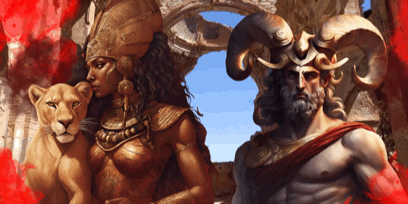
Mars’ Warriors
𓃭 aries 𓃭
✨💥planet energy, mythology & astrology obsvs✨💥


Aries Sun, Aries Rising, Venus, Mars
mars dominant, mars in the 1st house
Mars ruled.
Mars- Ascendant aspects, Sun-Mars Aspects
Strong Mars placements, Aries Stellium
✨💥“Her enemies had fallen. Sanguine showers painted the Earth a ghastly ruby hue. Wailing cries of defeat created a victorious symphony of which she savored…. cackling up at the heavens.”𓃭✨💥

Do not steal any of my original work & writing. Photos are either from Pinterest or collaged by me. All rights reserved. © 2024 The Siren Isles | Leave a tip if you enjoy!
✨Majestic Martian,
Ruled by the blood-red planet of Mars, you blaze a path on this Earth with an unwavering air of confidence.
✨💥Regal is the word that comes to mind.
Never needing reassurance, you literally believe you have already won before ever touching the battlefield.
Mars has blessed you with an innate, instinctual battlelust... an energy that inspires some, frightens others, but entrances ALL.
While everyone else contemplates... you act. You win the battle and even after you've won... you're still not satisfied.
✨💥You crave the next battlefield.. another King to slay.. another display of your hard-earned glory and greatness.
Even though January starts our calendar year, March begets Spring, the season symbolizing the beginning of life. Is it no surprise this month is named after your planetary ruler and the beginning of the zodiac?
Mars the planet is named after the Roman God of war and battlelust (Ares to the Greeks, Sekhmet to Ancient Egyptians) The Greeks deemed him the spirit of battle and child of Zeus and Hera.
With this energy, you have a natural, primal and intrinsic ability to tap into pure... red... RAGE. ✨💥 𓃭
While it sounds a bit frightening, this manifests as an incredibly useful gift in so many avenues of life. A Martian or Aries will always be ambitiously setting goals, achieving them, and writing more before they can catch a breath.
✨💥You have the spirit of a winner. You do not even fathom the thought of failure.
You move through life aware of the power of every single person in your immediate space, ready for someone to challenge the crown that you bled for.
This may be due to having literal experiences being attacked, bullied, and just… bothered. Your energy is akin to Plutonian/Scorpio, whose ancient ruler is Mars.
The element Fire clarifies and you are Cardinal Fire! You're literally blazing the trail. 🔥
A natural debater and concise communicator, you often find yourself defending yourself and others. (Always going to clear the room! Esp. to defend the ones you love. I love this for you all).
You have probably been admonished for your bold nature and aggressive style of communicating by adults, teachers, and maybe even... employers.
✨💥But, you are just being real. Your energy thrives in authenticity.
You hate being given orders and have probably fought hard to get into a career with relative freedom... this could manifest as entrepreneurism or content creating.

✨💥 She who mauls... 𓃭
The Mythology of Mars
While attempting to gain understanding of the energy of this sign and pIanet, I discovered the very simliar origin story in the Ancient Egyptian, Sekhmet, ("She who is powerful"). The goddess is depicted with the head of a female lion and ruled the desert sun, war, total chaos, and healing. I do want to clarify. This is not a male lion with the extravagant afro (symbol of Leo.)
Sekhmet manifests as a female lion because they are the fierce protector and huntress within the pack or pride, literally embodying primal female rage.
A female lion mauling is much like aftermath of a Martian or Aries temper explosion. It's not always a defensive energy, but a prowling one where the Martian sets its' sights on an easy mark.. or prey.
This could be a person or a task.
Egyptian mythology states she was created from the literal wrath of the sun God, Ra.
✨💥As the story goes:
Disappointed with the ungrateful treachery of men, Ra conspired with Set, God of Chaos to harness and manifest the wrath in which he felt... creating the embodiment of female rage, Sekhmet.
The stunning maiden possessing the spirit of war, is unleashed upon the people of Ancient Egypt, mauling anyone in her path until the waters of the great river ran...red.
Sekhmet was insatiable and her bloodlust lasted days.. She literally maniacally drank and gorged herself on the blood of the people. (Think: Akasha, Queen Mother of Vampires, in "Queen of the Damned")
Ra attempted to stop her, but being a daughter of the Sun... his powers had no effect. This drunken slaughter lasted until Thoth (Mercury to the Romans, Hermes to the Greeks) God of Trickery finally convinced her to drink wine under the guise of blood. The Goddess drank and fell asleep, calming the spirit.
✨💥I believe this is a valuable lesson anyone with dominant Mars energy has already learned quite a few times. You must utilize caution and strategy before rushing in.

✨💥THE ROMAN CIRCUS
On one hand, this is bad betch, rockstar, DIVA energy that can cosmically entrance the senses.
On the other... it can get a bit delusional…
✨💥 When I think of Aries energy, I think of the Roman Circus... (The Circus Maximus: Chariot Races, Gladiators, Live Animals, and Drunken Splendor.)
The event lured in many..under the guise of a celebration and glory. In reality, it was a grotesque sacrificial blood offering.
✨💥 To win the Roman Circus... was to suffer and harm many others. So, was it really a win at all?
This can be applied to the life struggles for some Martians or Aries who pursue a person or thing that is projecting a false but glorious image with everything they’ve got.
✨💥 I once knew an Aries sun who would always fall into silent competition with others girls because of just ONE Libra male in our social circle.
The Libra was a shameless flirt and seemingly a ladies man. However, he was very nonchalant towards the Aries sun... unresponsive to her direct energy. (Air sign men🙄)
She attempted numerous times, throwing very unsubtle hints sprinkled with arrogance. She knew that she was beautiful and wondered why he did not respect it.
✨💥 As beautiful as she was, she could not take the rejection. Aries HATES to lose. She needed to win.
Unbeknownst to the Aries sun, the guy was actually in the closet! Hiding his sexuality, he would only show his interest to women he knew weren’t interested... It was all a show and he was only projecting for societal benefits!
I share this story because I see this re-enacted amongst Martian and Aries women too often.
✨💥 In the spirit of battle, you set your sights upon who you deem as the most masculine man/woman or the one with the most options... because you want them to choose you above all.
You need to win. He becomes your Roman Circus. 𓃭✨💥
(Think: ariana grande & other people’s man; 1H mars 👀)
This happens to Martian men too… often rushing into a woman’s life before reading the fine print… only to have a cataclysmic collision of short-lived passion. 🫣
While I do applaud healthy competition, the female Martian complex often leads towards the Aries woman being trapped in a mothering role supporting a loser she only got because he used to be “the hottest guy in her area and everyone wanted him". (Giving major: Peaked in highschool mental vibes🤮)
✨💥You have a natural need to asess and rank a room according to power... or perceieved power. Badly aspected or unevolved Mars & even Pluto can make you exert force over those you deem weak.
However, those you perceive as powerful or heavily sought after seem to capture all of your romantic attention.
You want to conquer the most manly man and be the fierce queen at his side.
However, this desire comes from a need to feel glory. So people can become trophies… i.e. trophy wife or trophy husband.
HOWEVER, The problem with a "100% manly man… Toughest Hood Niiga… Greek God" archetype is that most men with these aesthetics did nothing to really gain them because they’re born handsome or are literally aware of the power of their own aesthetic!
Because your assertive energy is so direct and rivals that of a man at times… you can attract those pretty boys who are benefiting from male-pretty privilege & female sexual projection (i.e. the hottest and buffest guys girls assume will be the most sexual etc. NATE JACOBS CORE LOL)
✨💥Always remember… a less capable man is going to overcompensate!
He’ll be a knock-off designer... a fake… a fraud... and I am sorry to say, but I feel the biggest risks are (an unevolved Aries😭, Libra, Sags, GEMINI or Leo men...)
Not all of them, but they do have the tendency to exaggerate or be performative with their manhood. Pisces does this too, but they are not fooling an aries LOL.
✨����This can become that gross Mommy and Son energy I mentioned. Eventually... if they are lucky.. the Martian can snap out of their bloodlust daze to realize this guy was just acting... Any additional mental manipulations is what can create a toxic bond which is draining over time.
This relationship dynamic will be fun at first but it fizzles out when you realize he has the maturity of a child!
✨💥Run away from the man who puts on the show, ladies! It's what I call.. the Roman Circus.
With this energy, you can definitely be a bit overbearing when you are trying to show that you care. This is never minded too much by those who know your fiercly loving heart.
✨💥 You are a queen! Remember that what’s meant for you does not always have to be won over. It can manifest organically!
You are multi-faceted. Embrace diplomacy and take time to contemplate decisions like your sister sign, Libra.
Your Martian sibling, Scorpio also teaches the lesson of patiently waiting and observing the situation before action.(No one is plotting like a Scorpio Mars 👀)
However, a Martian never stays down for long and always bounces back improved from life’s perils!✨💥
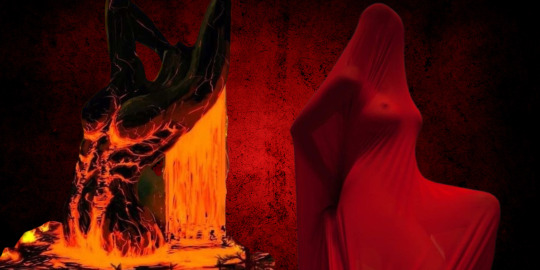
✨💥 Aries vs. Scorpio
Scorpio is a water sign, balancing out the fiery energy creating warm and inviting waves to lure you in.
Aries is a fire sign finding natural comfort in its sizzling Martian ruler and Solar energies... VA VA VOOM HOT..
✨💥The spirit of war lays waste to the lands and the God of the Underworld waits patiently to collect the souls.💥✨
𓃭
I believe Aries are our public leaders, change makers, warriors, and fierce inspiration. Their protective maternal energy is inherent and divine.
Sekhmet was equally feared and adored!
The likeness of the goddess can literally be found today in Egyptian art and architecture guarding the Pharoahs.
Much like Sekhmet and Ares, both Martian signs are an unstoppable force once in motion.
✨💥In the 1st house, Mars defines the personality and appearance. A perfect example is the feline-faced Nicki Minaj (Mars in the 1st house) on the left can be seen in what appears to be a Sekhmet inspired headress with lioness ears.


On the right… her Roman Circus🫣🙊😂(other 1H Mars women are Taylor Swift and Ariana Grande. Both have infamous love history!!)
✨💥I can literally hear Nicki’s iconic maniacal laughter… it legit sounds like what I’d imagine of blood-thirsty, Sekhmet after she’s slayed a Kingdom!
This can get a little egotistical… but she IS a queen. 🤷🏾♀️
I love my Martians though. You guys are so inspiring and honestly age like fine wine!! The youthful fire within you never really stops burning.
✨💥Be sure you are a productive force and not destroying all that lays in your path!
Thank you for reading! Wishing you blessings! ✨💥

@thesirenisles | masterlist | Enjoyed? Support!🧜🏾♀️

#divine feminine#mars#astrology#pluto#lilith#female rage#girl blogger#vampire#sekhmet#ancient egypt#ancient kemet#egyptian mythology#greek mythology#mythology#1st house#aries#scorpio#nicki minaj#dark feminine#isis goddess#bastet#astrology observations#astro#astro observations#aries stellium#mars in the 1st house#goddess#artists on tumblr#taylor swift#ariana grande
423 notes
·
View notes
Text
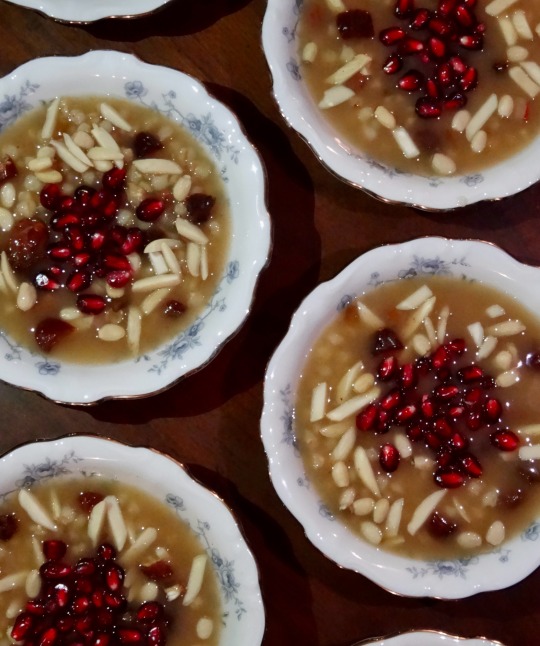
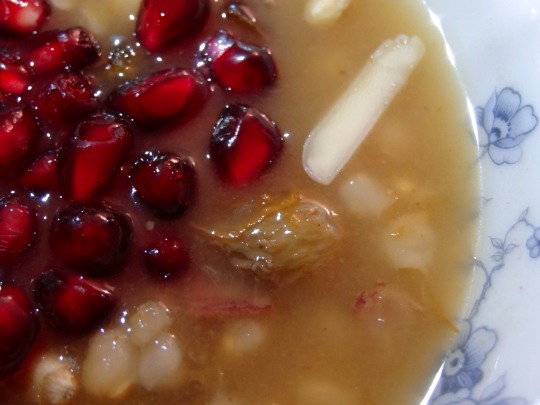
[ID: First image shows four small porcelain bowls of a pudding topped with slivered almonds and pomegranates seeds, seen from above. Second image is an extreme close-up showing the blue floral pattern on the china, slivered almonds, golden raisins, and pomegranate seeds on top of part of the pudding. End ID]
անուշապուր / Anush apur (Armenian wheat dessert)
Anush apur is a sweet boiled wheat pudding, enriched with nuts and dried fruits, that is eaten by Armenians to celebrate special occasions. One legend associates the dish with Noah's Ark: standing on Mt. Ararat (Արարատ լեռը) and seeing the rainbow of God's covenant with humanity, Noah wished to celebrate, and called for a stew to be prepared; because the Ark's stores were diminishing, the stew had to be made with small amounts of many different ingredients.
The consumption of boiled grains is of ancient origin throughout the Levant and elsewhere in West Asia, and so variations of this dish are widespread. The Armenian term is from "անուշ" ("anush") "sweet" + "ապուր" ("apur") "soup," but closely related dishes (or, arguably, versions of the same dish) have many different, overlapping names.
In Arabic, an enriched wheat pudding may be known as "سْنَينِيّة" ("snaynīyya"), presumably from "سِنّ" "sinn" "tooth" and related to the tradition of serving it on the occasion of an infant's teething; "قَمْح مَسْلُوق" ("qamḥ masluq"), "boiled wheat"; or "سَلِيقَة" ("salīqa") or "سَلِيقَة القَمْح" ("salīqa al-qamḥ"), "stew" or "wheat stew," from "سَلَقَ" "salaqa" "to boil." Though these dishes are often related to celebrations and happy occasions, in some places they retain an ancient association with death and funerary rites: qamh masluq is often served at funerals in the Christian town of بَيْت جَالَا ("bayt jālā," Beit Jala, near Bethlehem).
A Lebanese iteration, often made with milk rather than water, is known as "قَمْحِيَّة" ("qamḥīyya," from "qamḥ" "wheat" + "ـِيَّة" "iyya," noun suffix).
A similar dish is known as "بُرْبَارَة" ("burbāra") by Palestinian and Jordanian Christians when eaten to celebrate the feast of Saint Barbara, which falls on the 4th of December (compare Greek "βαρβάρα" "varvára"). It may be garnished with sugar-coated chickpeas and small, brightly colored fennel candies in addition to the expected dried fruits and nuts.
In Turkish it is "aşure," from the Arabic "عَاشُوْرَاء" ("'āshūrā"), itself from "عَاشِر" ("'āshir") "tenth"—because it is often served on the tenth day of the month of ٱلْمُحَرَّم ("muḥarram"), to commemorate Gabriel's teaching Adam and Eve how to farm wheat; Noah's disembarkment from the Ark; Moses' parting of the Red Sea; and the killing of the prophet الْحُسَيْن بْنِ عَلِي (Husayn ibn 'Ali), all of which took place on this day in the Islamic calendar. Here it also includes various types of beans and chickpeas. There is also "diş buğdayı," "tooth wheat" (compare "snayniyya").
These dishes, as well as slight variations in add-ins, have varying consistencies. At one extreme, koliva (Greek: "κόλλυβα"; Serbian: "Кољиво"; Bulgarian: "Кутя"; Romanian: "colivă"; Georgian: "კოლიო") is made from wheat that has been boiled and then strained to remove the boiling water; at the other, Armenian anush apur is usually made thin, and cools to a jelly-like consistency.
Anush apur is eaten to celebrate occasions including New Year's Eve, Easter, and Christmas. In Palestine, Christmas is celebrated by members of the Armenian Apostolic church from the evening of December 24th to the day of December 25th by the old Julian calendar (January 6th–7th, according to the new Gregorian calendar); Armenian Catholics celebrate on December 24th and 25th by the Gregorian calendar. Families will make large batches of anush apur and exchange bowls with their neighbors and friends.
The history of Armenians in Palestine is deeply interwoven with the history of Palestinian Christianity. Armenian Christian pilgrimages to holy sites in Palestine date back to the 4th century A.D., and permanent Armenian monastic communities have existed in Jerusalem since the 6th century. This enduring presence, bolstered by subsequent waves of immigration which have increased and changed the character of the Armenian population in Palestine in the intervening centuries, has produced a rich history of mutual influence between Armenian and Palestinian food cultures.
In the centuries following the establishment of the monasteries, communities of Armenian laypeople arose and grew, centered around Jerusalem's Վանք Հայոց Սրբոց Յակոբեանց ("vank hayots surbots yakobeants"; Monastery of St. James) (Arabic: دَيْر مَار يَعْقُوب "dayr mār ya'qūb"). Some of these laypeople were descended from the earlier pilgrims. By the end of the 11th century, what is now called the Armenian Quarter—an area covering about a sixth of the Old City of Jerusalem, to the southwest—had largely attained its present boundaries.
Throughout the 16th and 17th centuries, the Patriarchate in Jerusalem came to have direct administrative authority over Armenian Christians across Palestine, Lebanon, Egypt, and Cyprus, and was an important figure in Christian leadership and management of holy sites in Jerusalem (alongside the Greek Orthodox and Roman Catholic churches). By the middle of the 19th century, a small population of Armenian Catholics had joined the larger Armenian Apostolic community as permanent residents in Jerusalem, living throughout the Muslim Quarter (but mostly in a concentrated enclave in the southwest); in the beginning of the 20th century, there were between 2,000 and 3,000 Armenians of both churches in Palestine, a plurality of whom (1,200) lived in Jerusalem.
The Turkish genocide of Armenians beginning in 1915 caused significant increases in the populations of Armenian enclaves in Palestine. The Armenian population in Jerusalem grew from 1,500 to 5,000 between the years of 1918 and 1922; over the next 3 years, the total number of Armenians in Palestine (according to Patriarchate data) would grow to 15,000. More than 800 children were taken into Armenian orphanages in Jerusalem; students from the destroyed Չարխափան Սուրբ Աստվածածին վանք (Charkhapan Surb Astvatsatsin Monastery) and theological seminary in Armash, Armenia were brought to the Jerusalem Seminary. The population of Armenian Catholics in the Muslim Quarter also increased during the first half of the 20th century as immigrants from Cilicia and elsewhere arrived.
The immediate importance of feeding and housing the refugees despite a new lack of donations from Armenian pilgrims, who had stopped coming during WW1—as well as the fact that the established Armenian-Palestinians were now outnumbered by recent immigrants who largely did not share their reformist views—disrupted efforts on the part of lay communities and some priests to give Armenian laypeople a say in church governance.
The British Mandate, under which Britain assumed political and military control of Palestine from 1923–1948, would further decrease the Armenian lay community's voice in Jerusalem (removing, for example, their say in elections of new church Patriarchs). The British knew that the indigenous population would be easier to control if they were politically and socially divided into their separate religious groups and subjected to the authority of their various religious hierarchies, rather than having direct political representation in government; they also took advantage of the fact that the ecclesiastical orders of several Palestinian Christian sects (including the Armenian Patriarchate of Jerusalem) comprised people from outside of Palestine, who identified with religious hierarchy and the British authorities more than they identified with the Palestinian lay communities.
British policy, as well as alienating Armenians from politics affecting their communities, isolated them from Arab Palestinians. Though the previously extant Armenian community (called "քաղաքացի" "kaghakatsi," "city-dwellers") were thoroughly integrated with the Arab Palestinians in the 1920s, speaking Arabic and Arabic-accented Armenian and eating Palestinian foods, the newer arrivals (called "زُوَّار" / "զուվվար" "zuwwar," "visitors") were unfamiliar with Palestinian cuisine and customs, and spoke only Armenian and/or Turkish. Thus British policies, which differentiated people based on status as "Arab" (Muslim and Christian) versus "Jewish," left new Armenian immigrants, who did not identify as Arab, disconnected from the issues that concerned most Palestinians. They were predominantly interested in preserving Armenian culture, and more concerned with the politics of the Armenian diaspora than with local ones.
Despite these challenges, the Armenian Patriarchate of Jerusalem came to be a vital center of religious and secular culture for the Armenian diaspora during the British Mandate years. In 1929, Patriarch Yeghishe Turian reëstablished the Սուրբ Յակոբեանց Տպարան ("surbots yakobeants taparan"; St. James printing house); the Patriarchate housed important archives relating to the history of the Armenian people; pilgrimages of Armenians from Syria, Lebanon, and Egypt increased and the economy improved, attracting Armenian immigrants in higher numbers; Armenians held secular roles in governance, policing, and business, and founded social, religious, and educational organizations and institutions; Armenians in the Old and New Cities of Jerusalem were able to send financial aid to Armenian victims of a 1933 earthquake in Beirut, and to Armenians expelled in 1939 when Turkey annexed Alexandretta.
The situation would decline rapidly after the 1947 UN partition resolution gave Zionists tacit permission to expel Palestinians from broad swathes of Palestine. Jerusalem, intended by the plan to be a "corpus separatum" under international administration, was in fact subjected to a months-long war that ended with its being divided into western (Israeli) and eastern (Palestinian) sections. The Armenian population of Palestine began to decline; already, 1947 saw 1,500 Armenians resettled in Soviet Armenia. The Armenian populations in Yafa and Haifa would fall yet more significantly.
Still, the Armenian Patriarchate of Jerusalem maintained its role as the center of Armenian life in Palestine; the compound provided food and shelter to thousands of Armenians during the Battle for Jerusalem and the Nakba (which began in 1948). Some Armenians formed a militia to defend the Armenian Quarter against Haganah shelling during the battle.
In the following years, historical British contributions to the shoring up of insular power in the Patriarchate would cause new problems. The Armenian secular community, no longer empowered to oversee the internal workings of the Patriarchate, could do nothing to prevent embezzling, corruption, and even the sale of church-owned land and buildings to settlers.
In 1967, Israeli military forces annexed East Jerusalem, causing another, albeit smaller, surge in Armenian emigration from the city. Daphne Tsimhoni estimates based on various censuses that the Armenian population of Jerusalem, which had reached 5,000-7,000 at its peak in 1945–6, had fallen back to 1,200 by 1978.
Today, as in the 20th century, Armenians in Jerusalem (who made up nearly 90% of the Armenian population of Palestine as of 1972) are known for the insularity of their community, and for their skill at various crafts. Armenian food culture has been kept alive and well-defined by successive waves of immigrants. As of 2017, the Armenian Patriarchate supplied about 120 people a day with Armenian dishes, including Ղափամա / غاباما "ghapama" (pumpkin stuffed with rice and dried fruits), թոփիկ / توبيك "topig" (chickpea-and-potato dough stuffed with an onion, nut, fruit, and herb filling, often eaten during Lent), and Իչ / ايتش "eetch" (bulgur salad with tomatoes and herbs).
Restaurants lining the streets of the Armenian and Christian quarters serve a mixture of Armenian and Palestinian food. Լահմաջո "lahmadjoun" (meat-topped flatbread), and հարիսա / هريس "harisa" (stew with wheat and lamb) are served alongside ֆալաֆել / فلافل ("falafel") and մուսախան / مسخن ("musakhkhan"). One such restaurant, Taboon Wine Bar, was the site of a settler attack on Armenian diners in January 2023.
Up until 2023, despite fluctuations in population, the Armenian community in Jerusalem had been relatively stable when compared to other Armenian communities and to other quarters of the Old City; the Armenian Quarter had not been subjected to the development projects to which other quarters had been subjected. However, a deal which the Armenian Patriarchate had secretly and unilaterally made with Israel real estate developer Danny Rotham in 2021 to lease land and buildings (including family homes) in the Quarter led Jordan and Palestine to suspend their recognition of the Patriarch in May of 2023.
On 26th October, the Patriarchate announced that it was cancelling the leasing deal. Later the same day, Israeli bulldozers tore up pavement and part of a wall in حديقة البقر ("ḥadīqa al-baqar"; Cows' Garden; Armenian: "Կովերի այգու"), the planned site of a new luxury hotel. On 5th November, Rothman and other representatives of Xana Gardens arrived with 15 settlers—some of them with guns and attack dogs—and told local Armenians to leave. About 200 Armenian Palestinians arrived and forced the settlers to stand down.
On 12th and 13th November, the developer again arrived with bulldozers and attempted to continue demolition. In response, Armenian Palestinians have executed constant sit-ins, faced off against bulldozers, and set up barricades to prevent further destruction. The Israeli occupation police backed settlers on another incursion on 15th November, ordering Armenian residents to vacate the land and arresting three.
On December 28th, a group of Armenian bishops, priests, deacons, and seminary students (including Bishop Koryoun Baghdasaryan, the director of the Patriarchate's real estate department) were attacked by a group of more than 30 people armed with sticks and tear gas. The Patriarchate attributed this attack to Israeli real estate interests trying to intimidate the Patriarchate into abandoning their attempt to reverse the lease through the court system. Meanwhile, anti-Armenian hate crimes (including spitting on priests) had noticeably increased for the year of 2023.
These events in Palestine come immediately after the ethnic cleansing of Լեռնային Ղարաբաղ ("Lernayin Gharabagh"; Nagorno-Karabakh); Israel supplied exploding drones, long-range missiles, and rocket launchers to help Azerbaijan force nearly 120,000 Armenians out of the historically Armenian territory in September of 2023 (Azerbaijan receives about 70% of its weapons from Israel, and supplies about 40% of Israel's oil).
Support Palestinian resistance by donating to Palestine Action’s bail fund; buying an e-sim for distribution in Gaza; or donating to help a family leave Gaza.
Ingredients
180g (1 cup) pearled wheat (قمح مقشور / խոշոր ձաւար), soaked overnight
3 cups water
180-360g (a scant cup - 1 3/4 cup) sugar, or to taste
Honey or agave nectar (optional)
1 cup total diced dried apricots, prunes, golden raisins, dried figs
1 cup total chopped walnuts, almonds, pistachios
1 tsp rosewater (optional)
Ceylon cinnamon (դարչին) or cassia cinnamon (կասիա)
Aniseed (անիսոն) (optional)
Large pinch of salt
Pomegranate seeds, to top (optional)
A Palestinian version of this dish may add pine nuts and ground fennel.
Pearled wheat is whole wheat berry that has gone through a "pearling" process to remove the bran. It can be found sold as "pearled wheat" or "haleem wheat" in a halal grocery store, or a store specializing in South Asian produce.
Amounts of sugar called for in Armenian recipes range from none (honey is stirred into the dish after cooking) to twice the amount of wheat by weight. If you want to add less sugar than is called for here, cook down to a thicker consistency than called for (as the sugar will not be able to thicken the pudding as much).
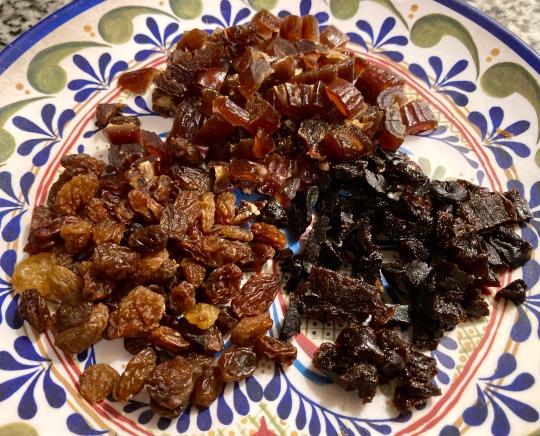
Instructions
1. Submerge wheat in water and scrub between your hands to clean and remove excess starch. Drain and cover by a couple inches with hot water. Cover and leave overnight.
2. Drain wheat and add to a large pot. Add water to cover and simmer for about 30 minutes until softened, stirring and adding more hot water as necessary.

Wheat before cooking
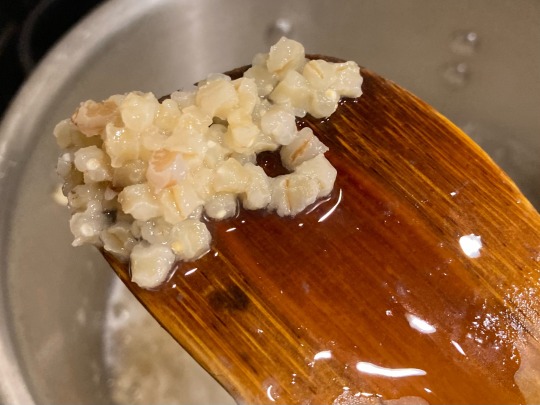
Wheat after cooking
3. Add dried fruit, sugar, salt, and spices and simmer for another 30 minutes, stirring occasionally, until wheat is very tender. Add water as necessary; the pudding should be relatively thin, but still able to coat the back of a spoon.
4. Remove from heat and stir in rosewater and honey. Ladle pudding into individual serving bowls and let cool in the refrigerator. Serve cold decorated with nuts and pomegranate seeds.
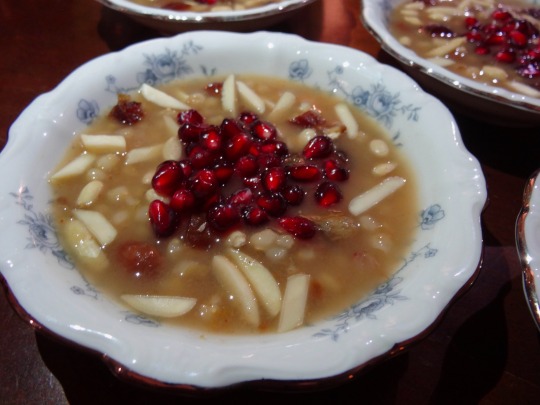
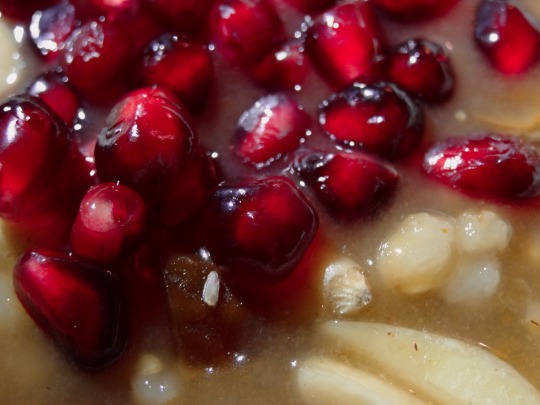
#the last link is a different / new fundraiser#Armenian#Palestinian#fusion#wheat berries#pearled wheats#pomegranate#prunes#dried apricot#dates#long post /
372 notes
·
View notes
Note

perhaps journalist Anthony geeking over how he somehow got supermodel Kate Sharma to be his wife ?
Journalist Anthony is absolutely… insane confused and befuddled about why one of the most beautiful women in the world agreed to date him, let alone the fact that they’re married.
He stands off the side the of her shoots, watching her work. and he stands back when they got to film premieres and fashion week, Watching people clamor for her attention. Watching as she tells other young girls how beautiful they are. How they don’t need to change for that.
“No offense, you’re a handsome guy,” Benedict mused one day as he watched Kate taking a photo with someone who’d asked for it as they left. “But how the hell are you married to that woman?”
Anthony laughed, “None take. There are millions of men who’d cut off their arm if it meant Kate Sharma would flirt with them. I’m not even a hold over from before she was famous who keeps her grounded which is the confusing thing. I’m just… she’s clearly insane though to be fair. She actually thinks she’s the lucky one.”
“I could do worse than you.” Kate laughed, kissing him quickly as she caught the tail end of their conversation. “I thought you were flirting with me at first anyway! Why else would you tell me you kept a calendar of me around?!”
“I panicked! I thought you would be mean and I didn’t know what to do! I didn’t expect insightful commentary!”
“More fool you, Anthony.”
“I was startled! You can’t just smile at men without warning, Kate. The Ancient Greeks used to fight wars over women who smiled like you did!”
Kate peered at Benedict, “I literally never thought I’d be married to a man desperate to tell me so much about the Trojan war but here we are. He’s cute when I tell him I loved the movie Troy.”
“It’s just not accurate, Kate! It’s not!”
130 notes
·
View notes
Text

Hellenic Polytheism or Hellenismos is the traditional, polytheistic (multiple gods) religious belief system of Ancient Greece. Modern people who believe in pre-Christian and polytheistic belief systems often refer to themselves as pagans. Let’s look at some of the general practices of typical Hellenic worship.
Hellenic Polytheists use altars or shrines to worship specific Gods within the Greek Pantheon. For example, an altar for Apollo may contain an image or sculpture bust of the god, as well as a side table, called a trapezōmata, which holds offerings of incense and flowers or food and drink such as wine, honey, milk, or olive oil. Another tripod incense holder was called a Thymiateria.
Before engaging in a ceremony, the practitioner will employ purification methods with lustral water (ritually cleansed). They may recite hymns or prayers in honor of the god, using the Homeric hymns for example. The practitioner may use a divination practice to seek guidance or gain insight from a god through methods like casting lots, reading signs from nature, oracle prophecies, and dream interpretations. In their ceremonies, ancient Greeks would perform rites in respect to their Ta Patria, (ancestral homeland heritage), and they would take pride in their reverence with Hos Kallista, or the highest level of beauty.
Hellenic Polytheism follows annual calendar festivals commemorating Gods or famous mythological events such as the Panathenaia in Athens (commemorating Athena), the Anthesteria and City Dionysia; (festivals celebrating Dionysus) The Olympics (a physical competition in honor of Zeus) and the Thargelia, (dedicated to Apollo and Artemis), and the Thesmophoria, (a festival exclusive to women in honor of Demeter), among many others.
Want to own my Illustrated Greek myth book jam packed with over 130 illustrations like this? Support my kickstarter for my book "lockett Illustrated: Greek Gods and Heroes" coming in October.You can also sign up for my free email newsletter. please check my LINKTREE:
#pagan#hellenism#greek mythology#tagamemnon#mythology tag#percyjackson#dark academia#greek#greekmyths#classical literature#percy jackon and the olympians#pjo#homer#iliad#classics#mythologyart#art#artists on tumblr#odyssey#literature#ancientworld#ancienthistory#ancient civilizations#ancientgreece#olympians#greekgods#zeus#hesiod
563 notes
·
View notes
Photo

The ancient Olympic Games were a sporting event held every four years at the sacred site of Olympia, in the western Peloponnese, in honour of Zeus, the supreme god of the Greek religion. The games, held from 776 BCE to 393 CE, involved participants and spectators from all over Greece and even beyond. The Olympic Games were the most important cultural event in ancient Greece and they ran for 293 consecutive Olympiads. So important were the Games in the ancient world that they were even used as a basis for the calendar.
110 notes
·
View notes
Text
One Poem a Day: September
"beautiful" words related to September for your next poem/story

September - ninth month of the Gregorian calendar. Its name is derived from septem, Latin for “seven,” an indication of its position in the early Roman calendar.
Apple-polish - to use flattery or the doing of favors in order to win approval especially from a superior
Anecdotage - the telling of anecdotes (i.e., a usually short narrative of an interesting, amusing, or biographical incident)
Ardency - depth of feeling
Auburn - of a reddish-brown color
Autumnity - quality or condition characteristic of autumn
Bucolic - of, relating to, associated with, or typical of open areas with few buildings or people; idyllic
Cathexis - investment of mental or emotional energy in a person, object, or idea
Ceres - the Roman goddess of agriculture
Churn Supper - a feast at the end of the hay harvest
Cider - fermented apple juice often made sparkling by carbonation or fermentation in a sealed container
Cornucopian - being more than enough without being excessive
Demeter - the Greek goddess of agriculture
Effulgence - radiant splendor; brilliance
Estivo-autumnal - relating to or occurring in the summer and autumn
Felicific - causing or intended to cause happiness
Fête - a lavish often outdoor entertainment
Gemütlich - agreeably pleasant; comfortable
Georgic - a poem dealing with agriculture
Harvest - the season for gathering in agricultural crops
Hearthstone - the place where one lives
Husbandry - the cultivation or production of plants or animals
Moon (away) - to spend in idle reverie; dream
Odeum - a small roofed theater of ancient Greece and Rome used chiefly for competitions in music and poetry
Prosaic - being of the type that is encountered in the normal course of events
Reposeful - of a kind to induce ease and relaxation
Rubicundity - ruddy (i.e., having a healthy reddish color)
Sapphire - a gem variety of corundum in transparent/translucent crystals of a color other than red; a deep purplish-blue color
Surfeit - an intemperate or immoderate indulgence in something
Torridity - parched with heat especially of the sun; hot
Victual - to supply with food
Sources: 1 2 3
If any of these words inspire your writing, do tag me or send me a link. I'd love to read your work!
More: Word Lists
#word list#september#writing prompt#dark academia#spilled ink#writeblr#writers on tumblr#poets on tumblr#poetry#literature#langblr#linguistics#words#light academia#lit#autumn#writing inspiration#writing ideas#writing inspo#creative writing#writing reference#rene magritte#surrealism#landscape#nature#moon#writing resources
94 notes
·
View notes
Text
I made a new Advent Calendar. This time it’s got Ancient Greek Women of Myth in it - behind each door is a representation in lineart and digital watercolour of one of the mortal* women from Ancient Greek mythology. Some are from my back catalogue, some are from ClassicsTober, and quite a few are brand new for this calendar.
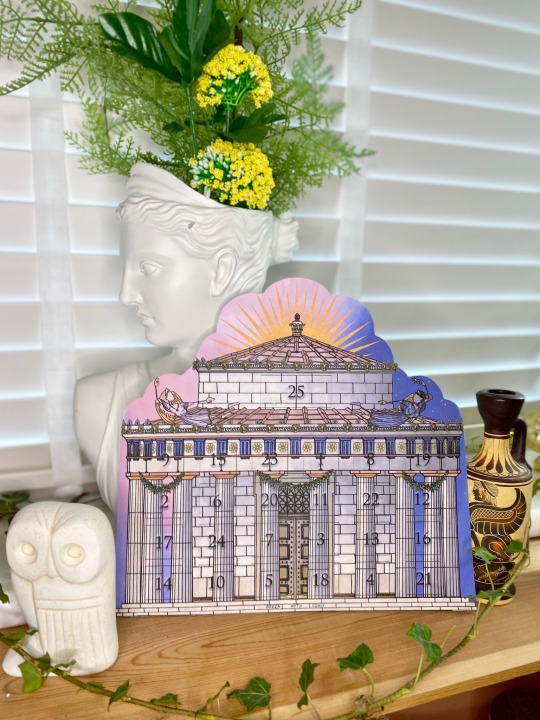

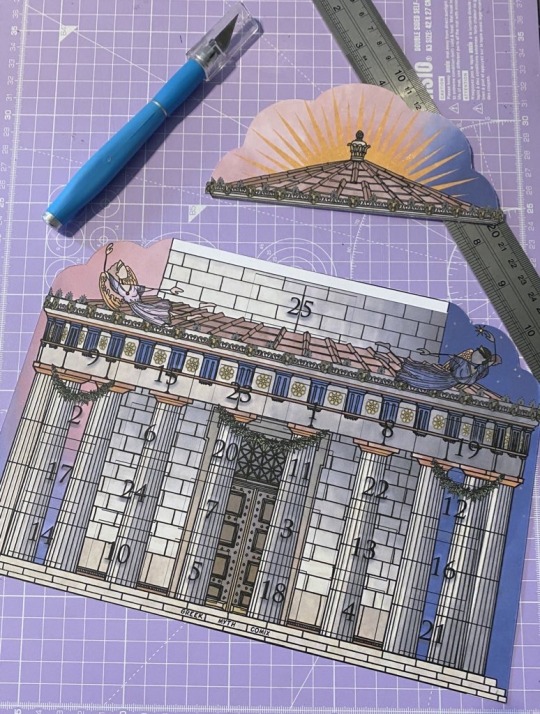
Somehow, I’ve already sold out the 50 order slots 🥰
I’m making a PDF version to put out probably at the end of the week, so you can make your own at home. It’s not too hard, just a lot of cutting! It will be with the rest of my download-and-print stuff on the http://greekmythcomixshop.wordpress.com website.
#advent#advent calendar#ancient greek advent calendar#alternative advent calendar#greek mythology#tagamemnon#greek myth#illustration#greek myth comix#comix#illustrator#ancient greek mythology#women of mythology#women of myth#Ancient Greek women
12 notes
·
View notes
Text
𝕸𝖔𝖓𝖙𝖍 𝕺𝖋 𝕲𝖆𝖒𝖊𝖑𝖎𝖔𝖓

14𝖙𝖍 𝖉𝖆𝖞 𝖔𝖋 𝕲𝖆𝖒𝖊𝖑𝖎𝖔𝖓
Third day of Lenaia (most probable period).
Theatrical competitions.
From the 🌕(♌) : Beginning of the Sacred Truce for the Lesser Mysteries until the 10th day of Elaphebolion. (IG 12, 6, 76-87)
''The fourteenth day of each month is called ''the most sacred'' because (Hesiod) praises the fourteenth day both as the day of the opening jars as the best of all; in fact, the lunar light is rich...the moon reaches the middle of the total distance into wich accomplishes her journey...since in the middle, in relation to the circle, perfection is found...'' (Scholia Erga 819)
Source: Hellenismo
Img: Museo Archeologico Nationale. Ancient roman mosaic that depicts a young Bacchus. Napoli House of the Faun, Pompei
#today#gamelion#hellenic calendar us#hellenic calendar#dionysos#dionysus lenaia#dionysus#dionysos lenaia#god dionysos#ancient greek theater
6 notes
·
View notes
Text
The gods of Gaul: Introduction, or why it is so hard to find anything
As I announced, I open today a series of post covering what some can call the "Gaulish mythology": the gods and deities of Ancient Gaul. (Personal decision, I will try avoiding using the English adjective "Gaulish" because... I just do not like it. It sounds wrong. In French we have the adjectif "Gaulois" but "Gaulish"... sounds like ghoulish or garrish, no thank you. I'll use "of Gaul", much more poetic)
[EDIT: I have just found out one can use "Gallic" as a legitimate adjective in English and I am so happy because I much prefer this word to "Gaulish", so I'll be using Gallic from now on!]
If you are French, you are bound to have heard of them one way or another. Sure, we got the Greek and Roman gods coming from the South and covering up the land in temples and statues ; and sure we had some Germanic deities walking over the rivers and mountains from the North-East to leave holiday traditions and folk-beliefs... But the oldest gods of France, the true Antiquity of France, was Gaul. And then the Roman Gaul, and that's already where the problems start.
The mythology of Gaul is one of the various branches of the wide group known as Celtic mythology or Celtic gods. When it comes to Celtic deities, the most famous are those of the British Isles, due to being much more preserved (though heavily Christianized) - the gods of Ireland and the Welsh gods are typically the gods every know about when talking about Celtic deities. But there were Celts on the mainland, continental Celts - and Gaul was one of the most important group of continental Celts. So were their gods.
Then... why does nobody know anything about them?
This is what this introduction is about: how hard it actually is to reconstruct the religion of Gaul and understand its gods. Heck we can't ACTUALLY speak of a Gaulish mythology because... we have no myth! We have not preserved any full myth or complete legend from Ancient Gaul. The pantheon of Gaul is the Celtic pantheon we probably know the least about...
Why? A few reasons.
Reason number one, and the most important: We have no record of what the Gauls believed. Or almost none. Because the people of Gaul did not write their religion.
This is the biggest obstacle in the research for the gods of Gaul. It was known that the art of writing was, in the society of Gaul, an elite art that was not for the common folks and used only for very important occasions. The druids were the ones who knew how to read and write, and they kept this prerogative - it was something the upper-class (nobility, rulers) could know, but not always. Writing was considered something powerful, sacred and magical not to be used recklessly or carelessly. As a result, the culture of Gaul was a heavily oral one, and their religion and myths were preserved in an oral fashion. Resulting in a great lack of written sources comng directly from the Gallic tribes... We do have written and engraved fragments, but they are pieces of a puzzle we need to reconstruct. We have votive offerings with prayers and demands inscribed on it - and while they can give us the names of some deities, they don't explain much about them. We have sculptures and visual representations of the deities on pillars and cups and jewels and cauldrons - but they are just visuals and symbols without names. We have calendars - but again, these are just fragments. We have names and images, and we need to make sense out of it all.
To try to find the explanations behind these fragments, comparisons to other Celtic religions and mythologies are of course needed - since they are all branches of a same tree. The same way Germanic mythology can be understood by looking at the Norse one, the same way Etruscan, Greek and Roman mythologies answer each other, the mythology and religion of Gaul has echoes with the Celtic deities of the Isles (though staying quite different from each other). The other comparison needed to put things back into context is reason number 2...
Reason number two: The Romans were there.
Everybody knows that the death of Ancient Gaul was the Roman Empire. Every French student learns the date of Alesia, the battle that symbolized the Roman victory over the Gallic forces. Gaul was conquered by the Romans and became one of the most famous and important provinces of the Roman Empire: it was the Gallo-Roman era.
The Romans were FASCINATED by Gaul. Really. They couldn't stop writing about them, in either admiration or hate. As a result, since we lack direct Gallic sources, most of what we know about Ancient Gaul comes from the Romans. And you can guess why it is a problem. Some records of their religion were written in hatred - after all, they were the barbarian ennemies that Romans were fighting against and needed to dominate. As such, they contain several elements that can be put in doubt (notably numerous references to brutal and violent human sacrifices - real depictions of blood-cults, or exaggeratons and inventions to depict the gods of Gaul as demonic monstrosities?) But even the positive and admirative, or neutral, records are biased because Romans kept comparing the religion of the Gauls to their own, and using the names of Roman deities to designate the gods of Gaul...
Leading to the other big problem when studying the gods of Gaul: the Roman syncretism. The Gallo-Roman era saw a boom in the depictions and representations of the Gallic gods... But in their syncretized form, fused with and assimilated to the Roman gods. As such we have lots of representations and descriptions of the "Jupiter of Gaul", of the "Mercury of Gaul", of the "Gallic Mars" or "Gallic Minerva". But it is extremely hard to identify what was imported Roman elements, what was a pure Gallic element under a Roman name, and what was born of the fusion of Gallic and Roman traditions...
Finally, reason number three: Gaul itself had a very complicated approach to its own gods.
We know there are "pan-gallic" gods, as in gods that were respected and honored by ALL the people of Gaul, forming the cohesion of the nation. But... Gaul wasn't actually a nation. It was very much like the many city-states of Greece: Ancient Gaul was unified by common traditions, a common society, a common religion and a common language... But Gaul was a tribal area divided into tribes, clans and villages, each with their own variations on the laws, each with their own customs and each with their own spin on religion. As a result, while there are a handful of "great gods" common to all the communities of Gaul, there are hundreds and hundreds of local gods that only existed in a specific area or around a specific town ; and given there were also many local twists and spins on the "great gods", it becomes extremely hard to know which divine name is a local deity, a great-common god, a local variation on a deity, or just a common nickname shared by different deities... If you find a local god, it can be indeed a local, unique deity ; or it can be an alternate identity of a shared divine archetype ; or it can be a god we know elsewhere but that goes by a different name here.
To tell you how fragmented Gaul was: Gaul was never a unified nation with one king or ruler. The greatest and largest division you can make identifies three Gauls. Cisalpine Gaul, the Gaul located in Northern Italy, conquered by the Romans in the second century BCE, and thus known as "the Gaul in toga" for being the most Roman of the three. Then there was the "Gaul in breeches" (la Gaule en braies), which borders the Mediterranean sea, spanning between the Alps and the Pyrenean mountains, and which was conquered in the 117 BCE (becoming the province of Narbonne). And finally the "Hairy Gaul", which stayed an independant territory until Cesar conquered it. And the Hairy Gaul itself was divided into three great areas each very different from each other: the Aquitaine Gaul, located south of the Garonne ; the Celtic Gaul located between the Garonne and the Marne (became the Gaul of Lyon after the Roman conquest) ; and finally the Belgian Gaul, located between the Marne and the Rhine. And this all is the largest division you can make, not counting all the smaller clans and tribes in which each area was divided. And all offering just as many local gods or local facets of a god...
And if it wasn't hard enough: given all the sculptures and visuals depictions of the gods of Gaul are very "late" in the context of the history of Gaul... It seems that the gods of Gaul were originally "abstract" or at least not depicted in any concrete form, and that it was only in a late development, shortly before the Roman invasions, that people of Gaul decided to offer engravings and statues to their gods, alternating between humanoid and animal forms.
All of this put together explains why the gods of Gaul are so mysterious today.
183 notes
·
View notes
Text
Ok so ...
Filament fever stage is interesting. One thing to point out is that the sculpture at the side of the stage. The animal sculpture looks like a deer with wings:

It's also in Meiko's trained card:

But for the virtual shop merch. Instead of the same animal, the merch instead has the pegasus instead as the sculpture:

So why the 3dmv stage did not use the pegasus and instead use deer with wings? The deer with wings that we know of is Peryton. Which, is similar to pegasus. A mythical beast.
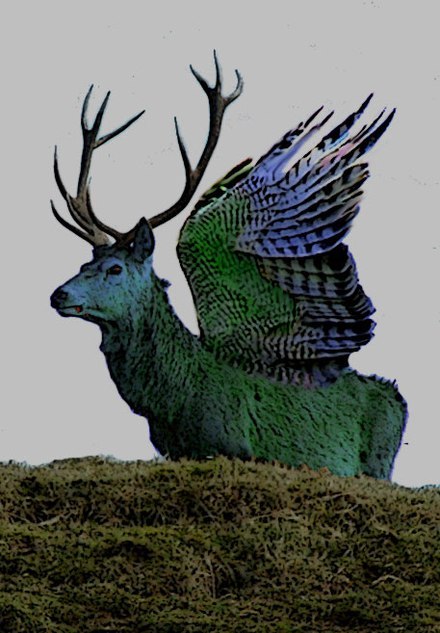
One of the things about Peryton is that the Peryton can "casts the shadow of a man until it kills one during its lifetime, at which time it starts to cast its own shadow".
This sounds very similar with Tsukasa's gacha banner name:

The text design here has a wing at the y. So what if, instead of the wings belong to a pegasus or a phoenix, the wings actually belongs to a peryton instead?
Also, although unclear, the peryton may derived from the Latin form of the Greek name of the fourth month on the ancient Macedonian calendar (Peritios, moon of January).
Coincidently the next wxs event, Rui event, starts on January. And there's also the moon in the filament fever 3dmv:

So I wonder if Tsukasa is now a peryton instead of a pegasus. Since there's some other lore point out that when the peryton finds its shadow, it can transform into a genuine bird. Like the star Tsukasa admires which is compared to the phoenix. Which is also a bird.
#project sekai#tsukasa tenma#wonderlands x showtime#wonderland sekai#rui kamishiro#wxs meiko#prsk analysis#prsk theory
205 notes
·
View notes